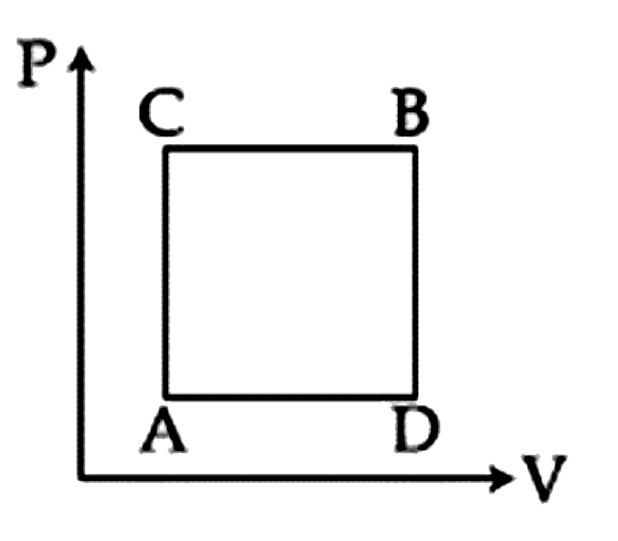A diamtomic molecule can be modelled as two rigid balls connected with a spring such that the balls can vibrate with respect to the center of mass of the system ( spring+balls) . Consider a diamtomic gas made of such diatomic molecules. If the gas performs 20 J of work under isobaric condition, then heat given to the gas ( in J ) is
The correct Answer is:70
To solve the problem of finding the heat given to a diatomic gas that performs 20 J of work under isobaric conditions, we can follow these steps:
1. Identify Degrees of Freedom:
For a diatomic molecule, the degrees of freedom (f) are 5 (3 translational + 2 rotational).
2. Calculate Specific Heat at Constant Volume (C_v):
The specific heat at constant volume for a diatomic gas is given by:
Cv=fR2=5R2
3. Calculate Specific Heat at Constant Pressure (C_p):
The specific heat at constant pressure is related to Cv by:
Cp=Cv+R=5R2+R=7R2
4. Work Done Under Isobaric Conditions:
We know that the work done (W) under isobaric conditions is given as 20 J.
5. Relate Heat Transfer (Q) to Work Done (W):
Under isobaric conditions, the heat added to the system can be expressed as:
Q=nCpΔT
where ΔT is the change in temperature.
6. Express ΔT in Terms of Work Done:
From the ideal gas law, we know that:
W=PΔV=nRΔT
Rearranging gives:
ΔT=WnR
7. Substitute ΔT into the Heat Equation:
Substitute ΔT back into the heat equation:
Q=nCp(WnR)=CpWR
8. Substitute Cp:
Now substitute Cp=7R2:
Q=7R2⋅WR=72W
9. Substitute the Given Work Done:
Given W=20J:
Q=72⋅20=70J
Final Answer:
The heat given to the gas is 70 J.
---
For a diatomic molecule, the degrees of freedom (f) are 5 (3 translational + 2 rotational).
The specific heat at constant volume for a diatomic gas is given by:
Cv=fR2=5R2
The specific heat at constant pressure is related to Cv by:
Cp=Cv+R=5R2+R=7R2
We know that the work done (W) under isobaric conditions is given as 20 J.
Under isobaric conditions, the heat added to the system can be expressed as:
Q=nCpΔT
where ΔT is the change in temperature.
From the ideal gas law, we know that:
W=PΔV=nRΔT
Rearranging gives:
ΔT=WnR
Substitute ΔT back into the heat equation:
Q=nCp(WnR)=CpWR
Now substitute Cp=7R2:
Q=7R2⋅WR=72W
Given W=20J:
Q=72⋅20=70J
The heat given to the gas is 70 J.
Similar Questions
Knowledge Check
The average degrees of freedom per molecule for a gas are 6. The gas performs 25J of work when it expands at constant pressure. The heat absorbed by gas is
A75 JB100 JC150 JD125 J
A driver having a definite reaction time is capable of stopping his car over a distance of 30 m on seeing a red traffic signal, when the speed of the car is 72 km/hr andover a distance of 10 m when the speed is 36 km/hr. Find the distance over which he can stop the car if it were running at a speed of 54 km/hr. Assume that his reaction time and the deceleration of the car remains same in all the three cases.
View SolutionA diatomic gas with rigid molecules does 10J of work when expanded at constant pressure. The heat energy absorbed by the gas, in this process is ___________ (in J).
View SolutionA diatomic gas with rigid molecules does 10J of work when expanded at constant pressure. The heat energy absorbed by the gas, in this process is ___________ (in J).
View SolutionA system consisting of one mole of an ideal diatomic gas absorbs 200J of heat and does 50J of work on surroundings. What is the change in temperature if vibrational modes of motion are inactive?
View SolutionA star can be considered as spherical ball of hot gas of radius R. Inside the star, the density of the gas is ρr at radius r and mass of the gas within this region is Mr.
The correct differential equation for variation of mass with respect to radius is (refer to the adjacent figure)
View SolutionTwo moles of an ideal monoatomic gas are contained in a vertical cylinder of cross sectional area A as shown in the figure. The piston is frictionless and has a mass m. At a certain instant a heater starts supplying heat to the gas at a constant rate qJ/s. Find the steady velocity of the piston under isobaric condition. All the boundaries are thermally insulated.

View SolutionA gas can be taken from A to B via two different processes ACB and DB.

When path ACB is used 60 J of heat flows into the system and 30J of work done by the system is 10 J , the heat flows into the system in the path ADB is :
View Solution
